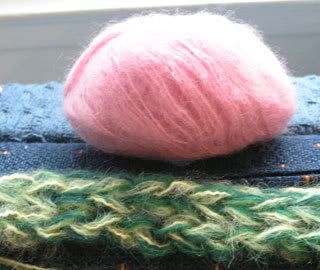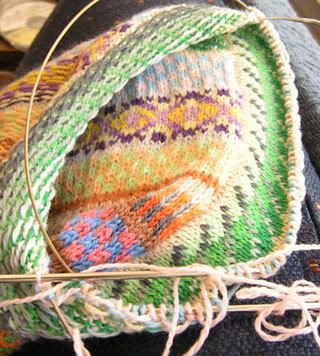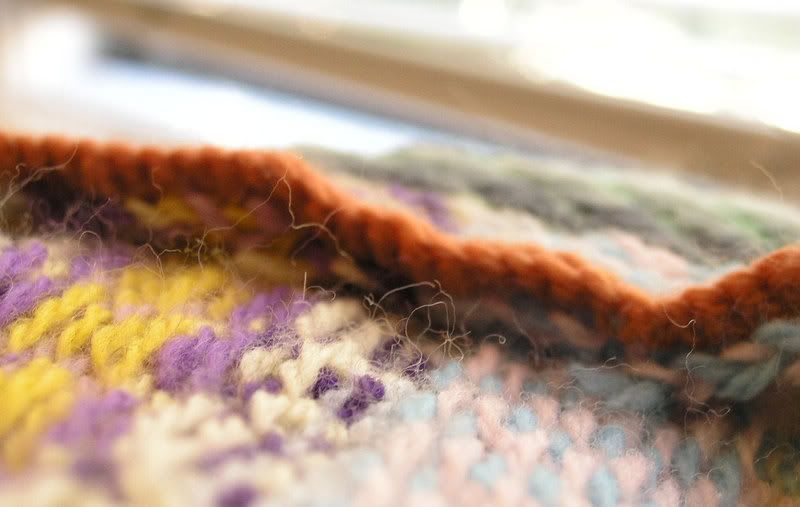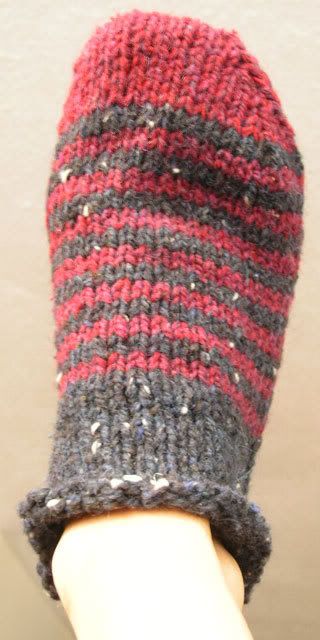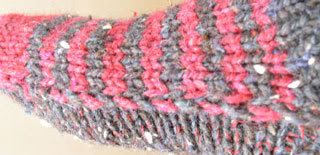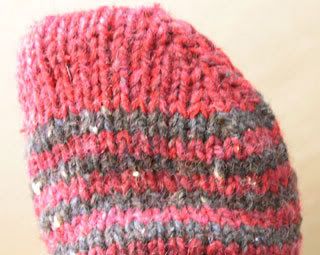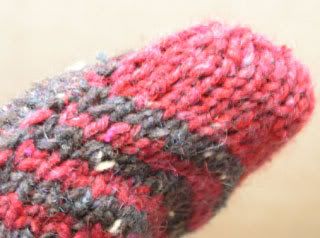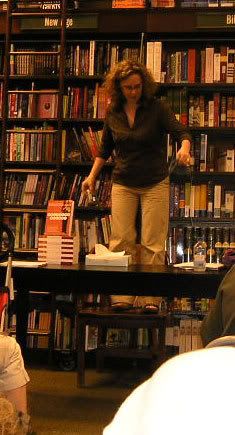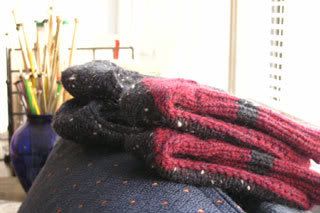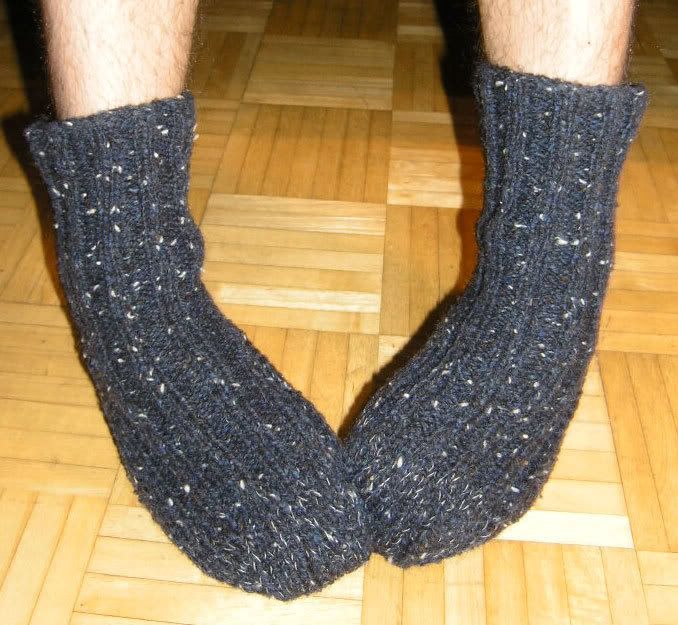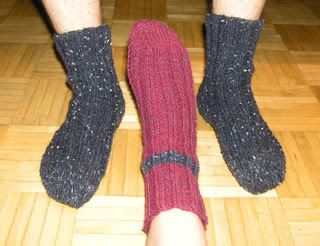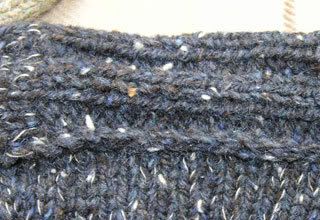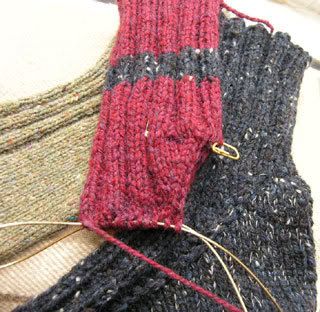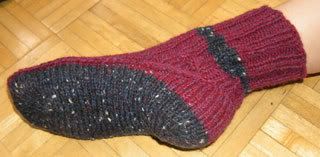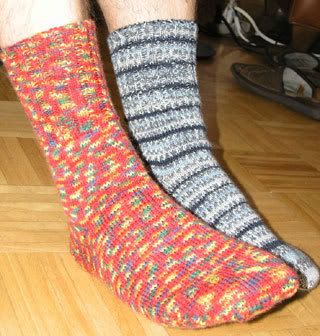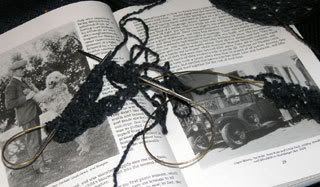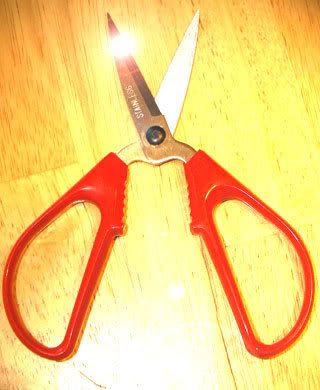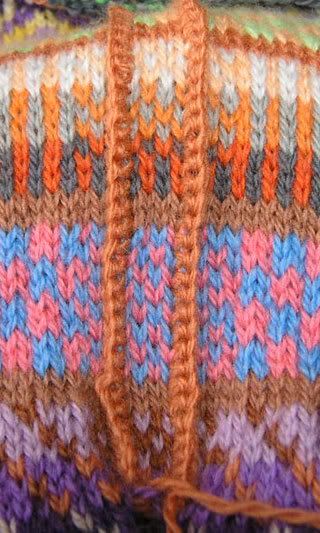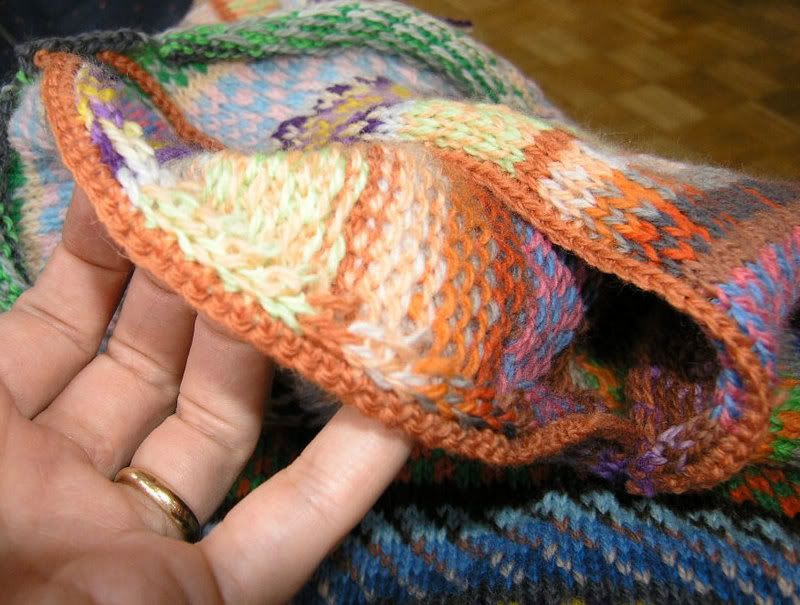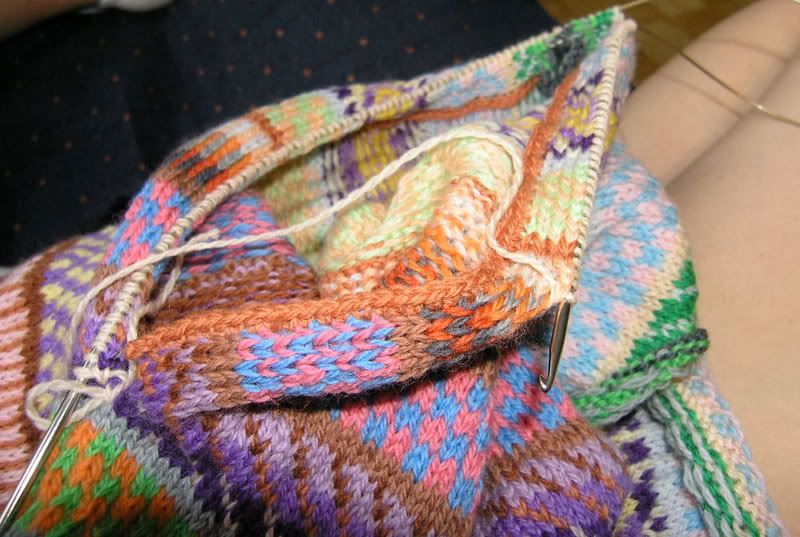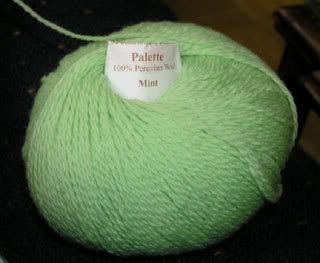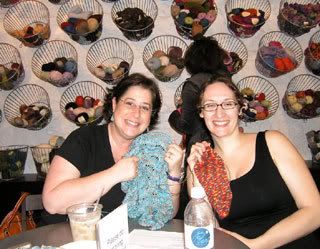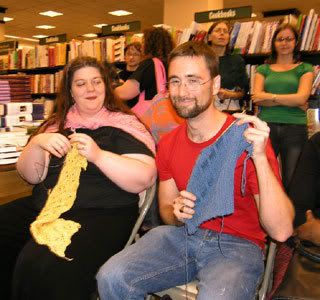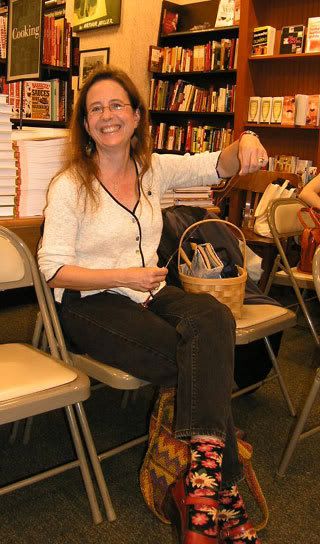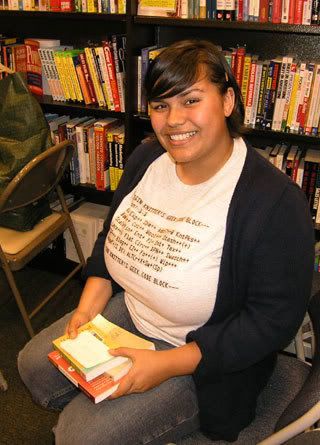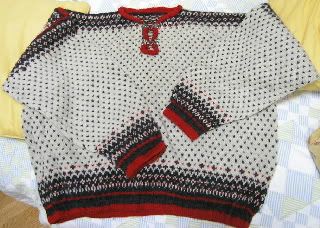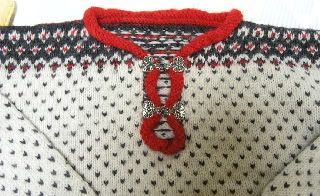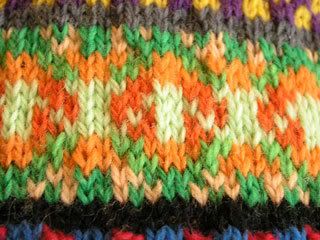I do agree with many that LB yarns have their uses. We have a good outlet here for LB here in NYC, at a little old-fashioned store called P&S Fabrics, south of Canal, so I have occasionally bought some LB stuff there, especially when I was first learning my way around yarn shopping, c. 2001. At P&S, they really specialize in Red Heart and Bernat, so the LB almost counts as high-end there. I go there pretty frequently for Patons Classic Wool for felting, and for cheap notions, but I've also purchased some LB wool-ease and microfiber in my time. And every time I've been dissatisfied - the microfiber was splitty and pilly, and the wool-ease felt too much like acrylic, especially over time, and ultimately convinced me that that was one thing I couldn't compromise on. I went back there recently to get kitchen cotton for Mason-Dixon projects, and considered the LB cotton...until I calculated the cost per weight of yarn and realized that it was much more expensive than Peaches and Cream for exacly the same product.
So, while it sort of gratifies me, as I said yesterday, to see that someone over there at Lion Brand actually woke up and realized that the stuff they were showing before didn't appeal to much of anyone who wasn't running a blog devoted to fug, on the whole I think the recent change we see in the catalog may have been wrought for sinister purposes. That is, I wonder whether they aren't hiking up their aesthetic as a way of hiking up the prices on what will still be the same old yarn. I think there is a place for cheap yarn (a big, gawping void to fill, in fact, between Red Heart and the sumptuous but pricey natural-fiber yarns), and I've always been appreciative of LB for fearlessly leaping in to cater to that market, and like I said, their yarn has its uses. But that's only if it stays cheap, and frankly, even before the catalog makeover it wasn't as cheap as it should be. When I can get sumptuous, natural-fiber yarns from KnitPicks for less, what's the point of Wool-Ease? I'd be only too delighted if LB took their cue from KnitPicks' success and start moving toward that same business model. But instead it looks - just looks, so far - like they might instead be moving toward higher glam, higher prices, same old crap, and hoping knitters will take a good long while to catch on. After all, thousands of people are still learning to knit everyday, and some of them never find the online knitting community. LB is heavily stocked at places like Wal-Mart, where there's no KnitPicks to compete with.
Coincidentally, just yesterday I browsed over to check out this controversy involving Tilli Tomas and price fixing, that Brenda Dayne mentioned on the last Cast-On. It sounds to me like LB is aspiring to do what Tilli Tomas and the other "luxury" yarn companies have been doing for a long time - trying to convince knitters - probably mostly the novices who should not be deliberately imposed upon in this way! - that just because a yarn is expensive, they're getting a "luxurious" experience out of knitting it. Never mind the relative qualities of the actual yarn! In fact, it looks from what I read on Sarah's blog like Tilli Tomas is pretty well convinced that their own yarn isn't worth what they want to charge for it.
Because of my grad student budget, I've always had to buy discounted or sale yarn, or get it in Russia where they import it directly from Peru, usually, or Spain or Germany, and sell it at what must be a very small markup (and what constitutes probably the maximum anyone would pay there, as salaries are so low), but the thing is - I've learned from experience that my yarns can do anything the super-expensive, lavishly-advertised yarns can do. The only yarns I really covet that I can't afford to find through KnitPicks, elann.com, School Products cones, at in-store sales or in Russia are hand-dyed and/or handspun, and I think most of those are worth every penny charged for them when they're made by hand by an experienced artisan who puts way more time into them than they can ever be properly compensated for. I've been to "String," the "luxury yarn" store on the Upper East Side, and while there were a few cashmeres at over $100 a skein that felt almost as soft as my Peruvian baby alpaca yarn from Moscow ($1.67), most of their stock looked...just like Lion Brand. Lots of eyelash and sequins and beads. And sure, the flashy bits might have been made of glass sometimes, and were undoubtedly attached to natural fibers instead of acrylic, but I personally found that, though they looked pretty on the skein, I didn't want to knit with them. Almost everything that wasn't just a ball of pure silk or cashmere (both of which can be tricky to knit with and are often better in a blend) was clearly meant as a scarf project - i.e., aiming straight for the novice knitter who maybe hasn't been in other yarn stores and doesn't know what to expect in terms of quality or prices. They're obviously catering to a certain crowd of very wealthy, mostly NYC/LA women who have latched on to the Hollywood side of the knitting trend and don't yet know enough about what makes a good knitting yarn, or what's a fair price, to see that they're being swindled. Some of these women will probably learn better and, hopefully, learn to spend their abundant cash on truly worthwhile artisan yarns, but many will probably just get over the knitting fad all too soon without ever realizing that they've essentially been cheated out of the best parts of the craft - making something beautiful of out truly high-quality materials.
As for the rest of us who only occasionally indulge in a yarn that means luxury to us, how many of us have been burned, either realizing later that another, less expensive yarn would have been as good, or paid a lot for a yarn that turned out to have yecchy qualities when knitted or washed? I suppose it's only natural in what is, on this scale at least, something of an emerging market. As consumers, we're learning how to buy yarn, and many manufacturers and distributors are testing the limits of our credibility. We are avid consumers, obsessed with our craft. Many, probably most of the individual small-scale yarn sellers (and some of the biggies, too!) are devoted, passionate crafters themselves who want only to connect knitters with the best materials and techniques. But there are also a lot of business people out there reading about "the new yoga" and hoping to cash in quick before we all catch on.
So...I want to catch on. I want to figure out how we, as knitters, can protect ourselves and our craft and develop our buying power into a strategy that will ensure a steady stream of high-quality yarn at reasonable prices for years and decades to come. Can we do this? Of course - knitters can do anything!
But what, specifically, can individual knitters do now? The discussion on Sarah's site is already working out some solutions. Brenda Dayne is clearly working on issues relating to these (and also to publishing and distributing patterns and techniques, a whole 'nother can of worms), and is devoting the next series of her wonderful podcast to problems of copyright and exploring creative commons laws. We can also all try to be more critical consumers and thinkers. I for one want to use my little yarn-buying budget to support the yarn sellers who operate in a way I really believe in (I think elann, KnitPicks and Webs are great, and am delighted to have learned now about Sarah's Yarns). In the same way that Brenda decided to accept sponsorship for her podcast only from companies that she wholeheartedly believes in as providing good quality at a good price in an ethical manner, we can all do the same every time we choose where to purchase a product. Of course, making good purchasing decisions depends on information, but this is where the internet in general and knit bloggers in particular really come in to save the day. There's never before been such an easy, fast, and adaptable way for any community to keep itself informed! In many ways, we all do this already, by recommending certain yarns or companies, and passing on warnings. Sarah is helping to make us all aware of the price-fixing issue, and I hope that information can be disseminated quickly all over the knit blogger community. But if the knitters who get hit hardest are those who have just stepped into a yarn store for the first time, and probably aren't yet plugged into the online knitting community and may never be - how do we let them know? I'm not sure there's a way, but the online knitting community is so huge and so avid that we might just be powerful enough as a lobby in our own right to have a real impact on the market for the better.
I suggested on Sarah's site that one small way to start would be a button, containing a constantly updated list of price-fixing yarn companies that bloggers could post on their sites as an indication of their intent to boycott these companies. The button could link back to the discussion on Sarah's blog or anywhere else to explain the situation. I see it as working kind of like the lists of companies kept by the Better Business Bureau - those that comply with basic good business practices (and the law) will be taken off the list, but those that get consistent complaints from consumers will stay on, to inform and warn other consumers. Companies will obviously have a strong incentive to stay off any such list, and that will, in effect, force them to comply with good business practices. Maybe we could also develop a gold-star list of great companies providing wonderful services - or maybe an annual awards extravanganza?? I've volunteered to make a plain anti-price-fixing button linking to Sarah's site (as those who know my blog know, it's not hard to make a plain button), but I don't know how to do anything more complicated. If you do, and you'd like to get involved - go to Sarah's site and let her know (she's offering free yarn!!) And, of course, either idea would require someone to put in some time to stay on top of the lists of companies. I can't do this and still finish my dissertation before my money runs out, but I'm sure someone out there can and will do it!
And the best thing we can all do, of course, is to first write to any companies we have problems with and give them the opportunity to adjust their practices and marketing to best please their customers, before we take any other measures. Most of them, I would assume, would be only too pleased to do so if they really see a strong response. Sarah lists the address for Tilli Tomas feedback on her site, and of course you can look up the Tilli Tomas site itself.
This post is not, I should mention, intended as a condemnation of Lion Brand yarns or the Lion Brand company. I haven't been a particularly great fan of their yarn since I've found better alternatives elsewhere, but I do think they offer a service to the knitting community and I have no knowledge of anything wrong with their business practices at all. Rather, the marketing change they've made in their recent catalog simply got me thinking, and made me wonder about what might, or might not, be behind it, and any possible connection to the price-fixing practices - and generally unpleasant marketing strategies - of the companies named in the discussion at Sarah's site. Same goes for what I said about String - I only conveyed my impression of my one brief visit there, and what this made me think about. I do not intend to imply anything beyond the heavily qualified and subjective statements actually made here in black and white.
I'd love to hear comments about any of these issues, and most of all suggestions as to how we as knitters and yarn buyers can best influence the yarn market in everyone's best interests.
